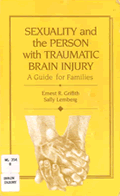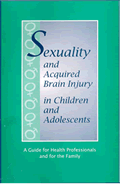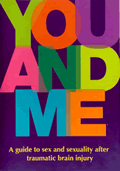- SELF STUDY MODULES
- 1. Intro to TBI
- 2. Communication
- 3. Skills for independence
- 4. Cognitive changes
- 5. Behaviour changes
- 6. Sexuality
- 7. Case management (BIR)
- 8. No longer available
- 9. Mobility & motor control
- 10. Mental health & TBI:
an introduction - 11. Mental health problems
and TBI: diagnosis
& management - 12. Working with Families
after Traumatic Injury:
An Introduction - 13. Goal setting
6.7 Resources
Resources include:
- Study module handouts and overheads that are used in the face to face workshops
- Recommended reading
- References
Study module handouts and overheads
Powerpoint presentation Module 6: 17 slides (PPT 2.6 Meg)
Handouts Module 6: 21 pages (PDF 147k)
Feedback on this module
Feedback and comments on this module are most welcome. We especially want to hear from people who have used all or part of the module. Click here to send us your comments and feedback
Take the TEST
Taking the TEST is a way of checking you have learnt the key concepts. It can also be a way of showing your organisation evidence that you have worked on the module.
The TEST includes 10 questions on the module content. You will also be able to access sample answers once you have completed the test.
Recommended reading
Griffith ER, Lemberg S. (1993). Sexuality and the Person with a Traumatic Brain Injury. A guide for families. FA Davis Co, Philadelphia.

References
Sexuality resources Dawson H, Hendy J, Simons M, Epps A. (1999) Sexuality and acquired brain injury in children and adolescents: A guide for health professionals and the family. Kids Health, New Childrens Hospital, Sydney.

Simpson GK. (1999) You and Me. An education program about sex and sexuality after traumatic brain injury (2nd ed.). Sydney: South West Sydney Area Health Service, 2003 Simpson GK. (1999) You and Me. A guide to sex and sexuality after traumatic brain injury (2nd ed.). Sydney: South West Sydney Area Health Service, 2003 (booklet)

Journal articles Elliott ML, Biever LS. Head injury and sexual dysfunction. Brain Injury.1996; 10:703–717.
Horn LJ, Zasler ND.(1990) Neuroanatomy and neurophysiology of sexual function. Journal of Head Trauma Rehabilitation, 5(2): 1-13.
Hibbard MR, Gordon WA, Flanagan S, et al. Sexual dysfunction after traumatic brain injury. NeuroRehabilitation. 2000; 15:107–120.
Kreuter M, Dahllof A-G, Gudjonsson G, Sullivan M, Siosteen A. Sexual adjustment and its predictors after traumatic brain injury. Brain Injury. 1998; 12:349–368.
Medlar TM. Sexual counselling and traumatic brain injury. Sexuality and Disability. 1993; 11:57–71.
Miller L. (1994) Sex and the brain-injured patient: Regaining love, pleasure and intimacy. The Journal of Cognitive Rehabilitation, 12:12-20.
Ponsford J. Sexual changes associated with traumatic brain injury. Neuropsychological Rehabilitation. 2003; 13:275–289.
Simpson GK. (2001) Addressing the sexual concerns of persons with traumatic brain injury in rehabilitation settings: A framework for action. Brain Impairment. 2 (2): 97-108.
Simpson GK, Blaszczynski A, Hodgkinson A. Sexual offending as a psychosocial sequela of traumatic brain injury. Journal of Head Trauma Rehabilitation.1999; 14: 1–16.
Walker AE (1976) The neurological basis of sex. Neurology India, 26(1):1-13.
Zencius A, Wesolowski M, Burke W, Hough S. Managing hypersexual disorders in brain-injured clients. Brain Injury. 1990; 4:175–181.
Physical disability/catheterisation
Burton, G.U. (1996) Issues of sexuality with physical dysfunction. In. Pedretti, L.W. (Ed) Occupational Therapy: Practice skills for physical dysfunction. 4th edition. St Louis: Mosby, pp.275-290.
Hebert L (1987) Sex and back pain. Advice on restoring comfortable sex that has been lost to back pain. Educational Opportunities, Maine.
Kroll, K. and Klein, E.L. (1992) Enabling Romance: A guide to love, sex and relationships for the disabled - and the people who care about them. New York: Harmony Books. Neistadt, M.E. and Baker, M. (1978) Choices: A guide to sex counselling with physically disabled adults. Malabar, Florida: Robert E. Krieger Publishing.
